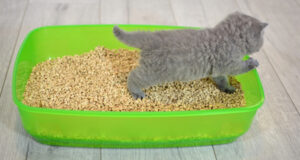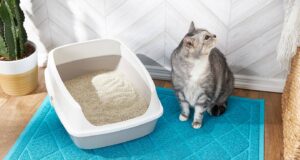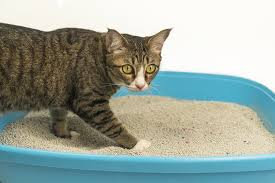Adapting to a new environment is not only exciting but also challenging. Cats have problems adapting to a new litter box.
Therefore, if a cat is expected to fit well in the litter box or new litter, the litter box must be set properly. If the required steps are taken, your cat will get more comfortable and at a faster rate.
This article explores the following:
- Steps to get a cat to use the new litter box and new litter.
- Reasons and advantages to change different cat litter.
- how often should you change the different new litter?

Table of Contents
5 Simple Steps to Get a Cat to Use a New Litter Box.

Step 1.
Place the litter box in a place familiar to the cat and with time gradually move it to your preferred location.
Do not put the box in rooms that are distant from where the cat relaxes. Avoid areas that create disturbance to the cat such as appliances and furnaces.
Also, avoid concrete floors. It is advisable to have an extra litter box as this will give the cat freedom to choose which one to use or get used to both of them.
Step 2.
Use fine grain-litter to fill the litter box.
The fine grain-litter should be less than two inches as many cats find this very comfortable. Some cats are very choosy and will prefer litter boxes that appeal to their smell and texture.
Step 3.
Use uncovered litter boxes as they are more comfortable and less irritating to the cat.
Cats greatly use their instincts and will find a covered litter box very intimidating.
Step 4.
Help the cat into the litter box and keep trying in case it jumps out.
Ensure that the cat is interested in observing signs such as sniffing the box. Reward the cat if it makes progress. Reinforce the positive behavior through special cat food or toys. Avoid punishments as these will only increase and stress the cat.
Step 5.
Observe litter box hygiene.
Clean the litter box regularly using unscented soap and water as this will help eliminate the bad smell due to waste and also make the litter box a pleasant place to live.
Things to Avoid when Getting the Cat into a New Litter Box.

In order to ensure that your cat adapt well to their new litter box, it is required that the following be avoided;
- Avoid placing the litter box in a place unfamiliar with the cat or a place that will cause disturbance as this will bring anxiety and stress to the cat and make them feel less comfortable.
- It is also wise to avoid covered litter boxes as these will make the cat feel intimidated and in extreme cases may not even adapt to the new litter box at all.
- Avoid keeping the litter box dirty. Clean the litter box daily using unscented soap and water to rid of the bad smell due to urine and feces. This unpleasant smell will cause the cat to feel
uncomfortable and stay away from the new litter box. - Also, avoid negative reinforcements on the cat as these will only cause them stress and anxiety and further keep them away from their litter box. Contrary, use positive reinforcements as these will encourage the cat to constantly strive to adapt to its new environment.
Why Won’t a Cat Use the New Litter Box?

The cat is especially susceptible to perception. Such perception may hinder from using a new litter box especially if it is conflicting. The following are some of the reasons why a cat will not use a new litter box:
The size of the litter box
A cat will decline from using a small litter box since a small litter box will be less comfortable or not comfortable at all. Cats are very playful and require a litter box where they will play comfortably sniff, and also dig with less effort.
Competition
Competition from multiple cats at home may lead to evitable conflict between the cats and this may trigger a refusal behavior since the cat will see this rivalry as very inappropriate and the stronger cat will be in control of the litter box. It is therefore advisable to have many litter boxes if the cats are many.
Position of the litter box
A cat may dislike the position of the litter box especially if it is placed in a position the cat is not familiar with or a place where the cat experiences disturbances due to physical barriers or appliances which cause disturbance to the cat.
Reasons for Changing New Cat Litter.
The reason for changing the new cat litter depends on the reaction of the cat towards that particular litter. The cat may find the texture and the smell unpleasant and therefore may feel that the particular is no longer appropriate and stay away from it completely.
Under such circumstances, it is wise to buy litter which the cat is used to and finds comfort. Furthermore, if the brand that you prefer is unavailable, you may opt to buy a new litter to replace the one you are used to.
Advantages of Switching New Litter.

Switching to a natural new litter reduces health hazards to you and your cat since it contains no perfumes or chemicals. Additionally, it is environmentally friendly.
Furthermore, this action is in line with other cat owners since people are in a transition to a more natural and friendly litter that is less expensive and less harmful.
However, changing new litter should be done gradually, and upon noticing some behavior change in your cat perhaps refusal to use the litter box action needs to be taken.
How to Introduce Your Cat into New Litter?

Cats are very sensitive creatures and for them to transition from one litter to another successfully; events that cause stress need to be eliminated. The following are steps on how to successfully introduce your cat into a new litter:
Step 1.
Arrange in layers the different litter with the new litter at the bottom and occupying ¼ of the litter box and the old litter at the top consisting ¾ of the content. The cat under normal circumstances will mix them naturally.
Step 2.
Continue by substituting old litter with new litter gradually.
Step 3.
Through observation, determine whether the cat is ready to accept the new litter and if it is, withdrawal the old litter completely.
Step 4.
Observe the reaction of the cat to verify if it has adapted to the new material or whether it still needs time.
Conclusion
In conclusion, cats are very sensitive creatures and should be handled with extra care and should be trained to fit well in the house and also adapt comfortably to their litter box while ensuring that the litter does not compromise their and that they don’t go releasing waste everywhere in the house.
